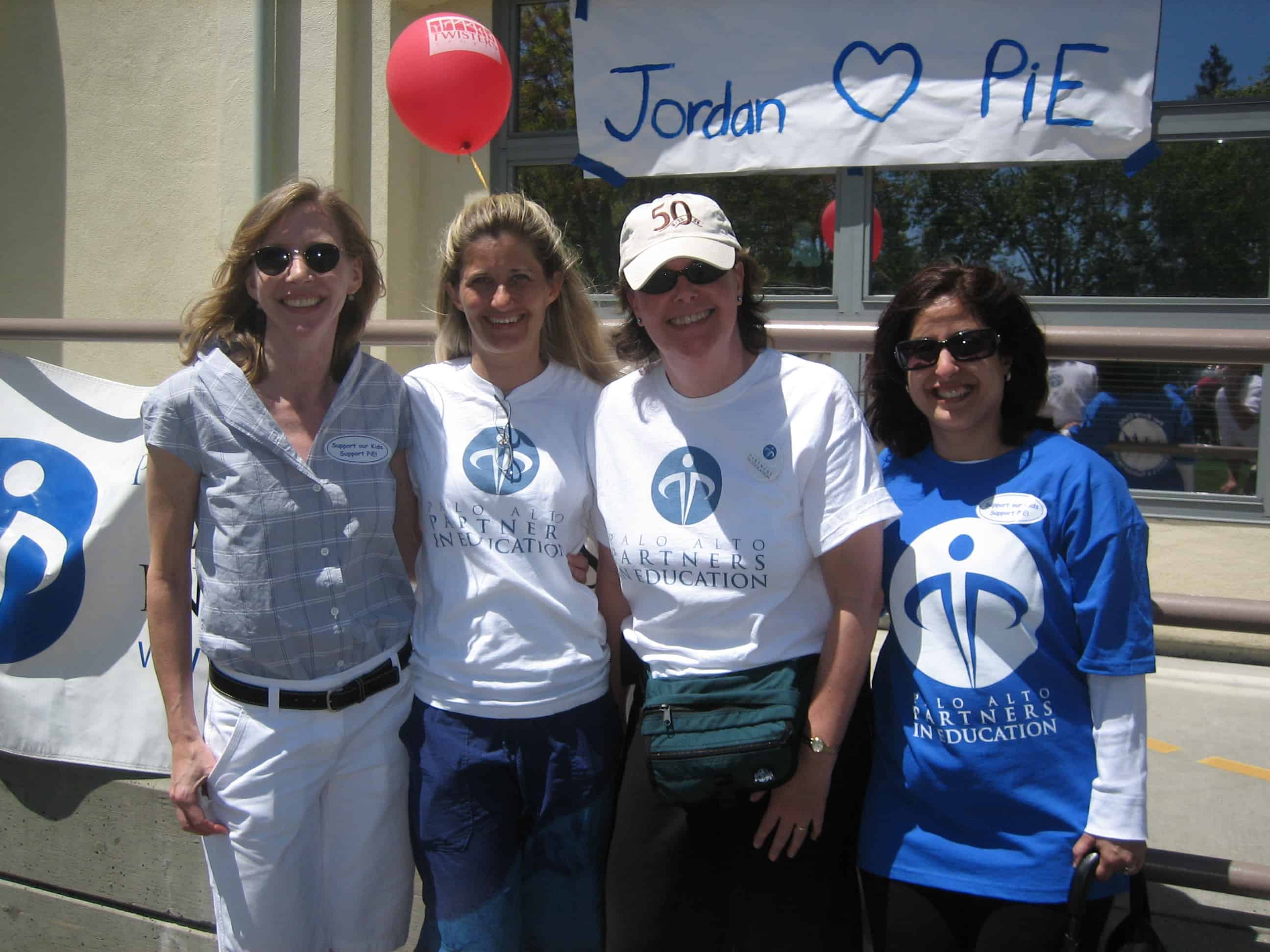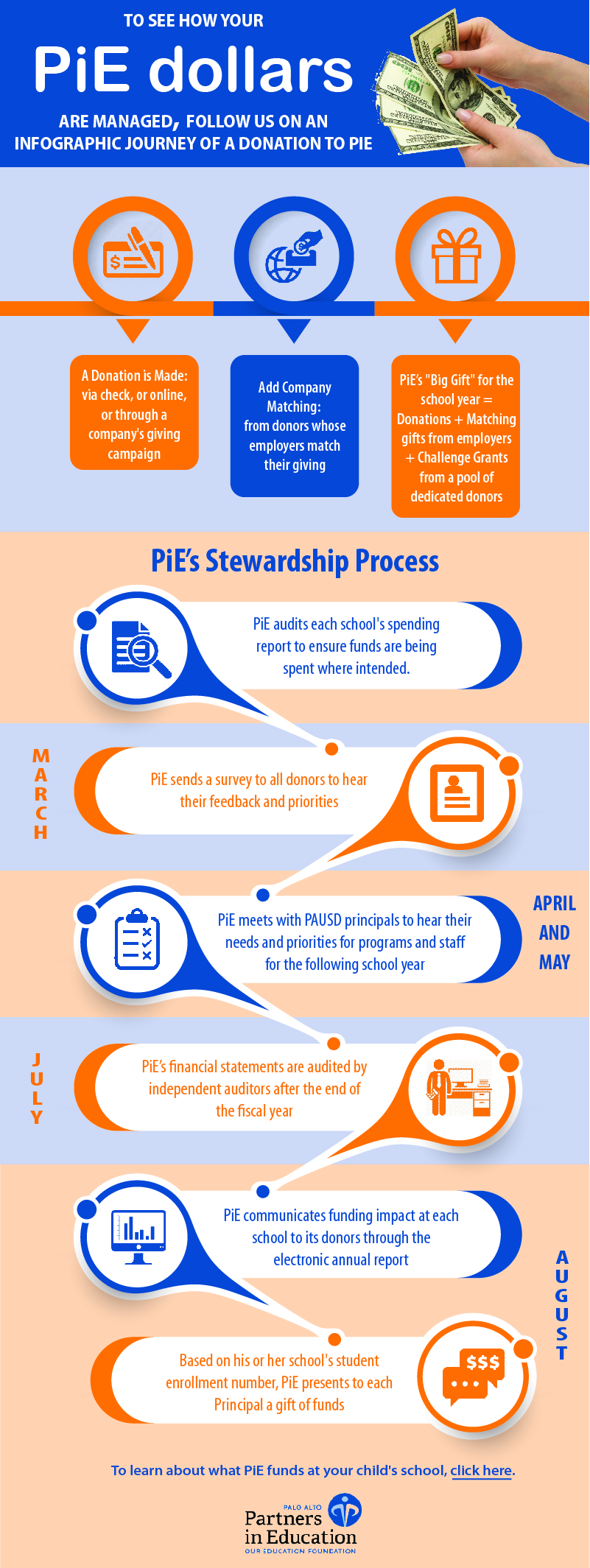The Slice – Fall 2017
[responsive] [/responsive]
[/responsive]
PiE is such an integral part of our schools, that it is hard to imagine them without it. Yet many PiE-funded programs that are a core part of a PAUSD education today, did not exist 10-15 years ago or were only available in a handful of schools.
This issue of Slice explores PiE—how it works and why it was created in the first place.
[hr style=”1″ margin=”20px 0px 20px 0px”]
An Interview with PiE’s Founders
“Our district is not being funded and our kids are not being supported at the same level as students elsewhere who are competing with our children to get in to college.”
So concluded Susan Bailey, the first President of PiE, upon reviewing the findings of a landmark 2006 School District Benchmarking Report. The report resulted after a group of Palo Alto parent volunteers personally flew back east and visited top performing school districts—Wellesley in Massachusetts, New Trier near Chicago, Chapel Hill in North Carolina, and Scarsdale in New York—to compare their resources, funding, and results, with those of PAUSD.
The Benchmarking Report was a key turning point in the formation of PiE as the organization we know today.
Recently, Ms. Bailey spoke to PiE’s current Board of Directors about the early days of PiE. She was joined by Brian Aronstam and Elaine Hahn, who were also instrumental in the formation of PiE.
The Reality of School Funding in California
School Nurses. Art. Technology. Classroom Aides. Class size and the ratio of students to staff.
In an apples-to-apples comparison of funding in high-performing public K-12 districts elsewhere in the U.S., the report showed that PAUSD schools were understaffed in these areas, “We were the lowest funded among districts in the study,” said Bailey.
When California Proposition 13 slashed public school funding, parent groups turned to various resources for additional staff and programs. While Palo Alto fared well in California, the results were still mixed. As recently as 2002, funding levels varied at schools across PAUSD and large inequities in the staff-to-student ratio grew between different schools.
The founders shared stories from extensive negotiations that were needed over several months and years, across all the different stakeholders, to create a district-wide sense of community and ownership and to arrive at a common goal that would benefit all students.
That core goal—which PiE follows today—was to create a non-profit dedicated to an enriched education for all PAUSD children.
“We are truly indebted to those parents and community members who were willing to pour their entrepreneurial time and expertise into creating a first-class education foundation that supports all our students in PAUSD. Their drive and dedication made it possible for PiE to be what it is today.”
— Susan Bailey, former President of PiE
Giving Wisely to Make a Difference
“To give away money is an easy matter and in any man’s power. But to decide to whom to give it and how large and when, and for what purpose and how, is neither in every man’s power nor an easy matter.”
— Aristotle
In 2016, Americans gave $390 billion to nonprofit organizations. 72% of this philanthropy ($282 billion) was from individuals. We give to solve a problem. We give to make an impact on a cause we support. We want the organizations to which we give to be fiscally prudent and professionally managed. We want our gifts to make a difference.
A Gold Standard Among Nonprofits
Among nonprofit education foundations, Palo Alto Partners in Education (PiE) is considered the gold standard. PiE has received the highest ratings from Charity Navigator and GuideStar for several years and counting.
PiE is audited by an independent outside accountant every year. The Audited Financial Statements and IRS 990 filings for several years can be found on the PiE Financials webpage. PiE’s total administration costs including salaries, rent, postage, professional fees (audit), and all costs for marketing and fundraising campaigns amount to less than 8% of the total revenue raised by PiE.
PiE is professionally led by a seasoned fundraising professional, Linda Lyon as Executive Director. Linda has an extensive background in fundraising, nonprofit leadership, and management in both the nonprofit and for-profit sectors. PiE also counts on two part-time staff members, Emily Jaquette and Dena Seki, who are active PAUSD parents with strong backgrounds in PTA leadership and impressive professional resumes.
Powered By Parents
PiE is powered by parents who want their donations to make a maximum impact for our students. PiE Representatives at every school are both parents and donors who care about their school community and about the education of all PAUSD children.
“During this season of giving, I want my donations to be used effectively. I am confident that PiE is using my donation to maximally support all of the children in PAUSD.”
— Julie Wissink, Escondido PiE Representative
At PiE, organizational oversight is provided by a “working” Board of Directors consisting of dedicated parent volunteers who represent nearly every school in PAUSD. The professional expertise of PiE Board Members spans the fields of law, accounting, operations, finance, education, nonprofit management, start-ups, marketing, fundraising, and more.
Do you ever wonder what happens after you give to PiE? See the Infographic image below to find out:
[hr style=”1″ margin=”20px 0px 20px 0px”]

